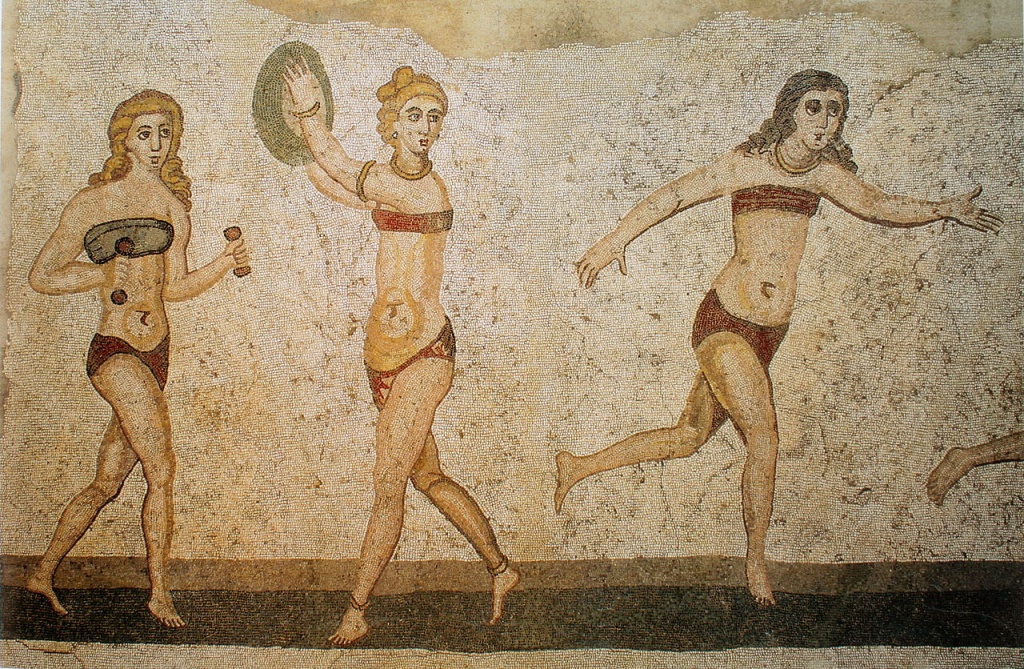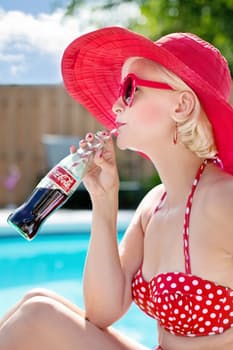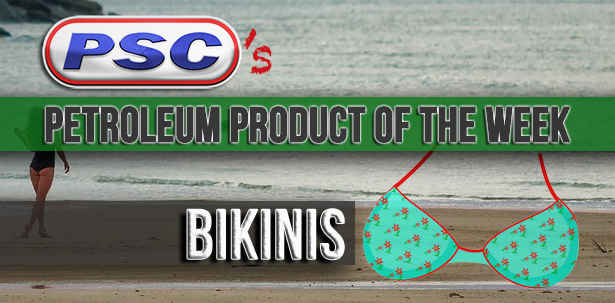She wore an…
Bikinis are controversial, to say the least, but with all the fantastic body-positive talk happening lately, they’re becoming more and more popular these days. And I love it.
These swatches of fabric have seen a lot over the years. They’ve been called names, banned from beaches, and more.
But they have persisted, and while some people loved to hate them, more people love to love them.
An Explosive History
Bikinis date as far aback as 4th century Rome. Mosaics from Sicily illustrate two-piece clothing items that women wore for athletic purposes.

During WWII, fabric was rationed and it is believed that this was what set off the bikini mindset in designers. Mostly, skirts were shortened and eliminated, but a few suits became two-pieces.
While versions of a one piece bathing suite and petticoat surfaced in the late 1800s and early 1900s, it wasn’t until around 1947 that the first controversial bikini was designed.
French engineer Louis Réard and designer Jacques Heim designed the two two pieces. The first was Heim’s “arome” and the second was the “bikini.” Réard named it after nuclear tests that were conducted at Bikini Atoll. He believed his design would be just as explosive.
At first, no one took to the design. At least not until Micheline Bernardini wore it.
https://www.youtube.com/watch?v=zzqVv-gKJcA
They were banned from beauty pageants around the world after the 1951 London Mill World Contest and were even deemed sinful by the Vatican.
In 1960, this beauty was released:
Brigitte Bardot is widely given credit for popularizing the bikini when she was photographed wearing one on every beach in the south of France. Then, in 1962, Swiss actress Ursula Andress wore her homemade bikini in the James Bond film Dr. No, further popularizing the swimsuit.
The first swimsuit issue of Sports Illustrated was printed in 1964, featuring a bikini-clad Babette March.
“In the austere postwar years, mankind needed something to bring peace and happiness to the planet once more. That thing was the bikini. Its perfection of form and function ensured that once again, mankind was united in a single thought: phwoar!” — Dominic Smith, editor Nuts
Films made the bikini even more popular and acceptable over the years in features like One Million Years BC, California Girls, Surfin’ Safari, and even Star Wars (Episode VI: Return of the Jedi).
These days, they come in all shapes, sizes, colors, and with as much or little coverage as you can imagine.
 What Makes ’em Up?
What Makes ’em Up?
Most bathing suits are made from synthetic material that is engineered to do things that a bathing suit should do. We want them to fit well, last long, keep their color, and dry fast. Petroleum often plays a large part in all that.
Nylon is a major player in the bikini game. This material is light, stretchy, and wicks away moisture to dry fast and keep you comfortable.
Spandex is often included in a blend of fabrics for bathing suits. The is soft, light, and form-fitting. It’s often used in competitive swimming, but chlorine can wear down the elasticity over time.
Polyester is sometimes used, though it has a lot of negatives when it comes to what you want in a suit. It’s not very stretchy, holds water, and can get heavy. Recently, polybutylene terephthalate (PBT) improved upon these. It reduces absorbency, increases the elasticity, and increases drying time.
Looking ahead, it is likely bathing suits will continue to be made of the same material we know now. However, innovations in technology will allow manufacturers to manipulate material shape further for more figure-enhancing suits.
No matter what your stance is in the bikini world, there’s just no denying that they truly had an explosive effect in the fashion world.
Sources:
http://www.elle.com/fashion/g2906/the-history-of-the-bikini-654900/?slide=1
http://content.time.com/time/photogallery/0,29307,1908353_1905442,00.html
https://www.leaf.tv/articles/types-of-fabric-used-for-swimsuits/







